The Tribaloy T-800 Coatings Deposited by Laser Engineered Net Shaping (LENSTM)
Abstract
:1. Introduction
2. Materials and Methods
2.1. Characterization of the Initial Powder
2.2. Experimental Procedures
3. Results and Discussion
3.1. Selection of LENS Parameters
3.2. Characterization of Obtained Coatings
3.2.1. Microstructure
3.2.2. Microhardness
3.3. Discussion
4. Conclusions
Author Contributions
Funding
Conflicts of Interest
References
- Zielinska, M.; Sieniawski, J. Surface modification and its influence on the microstructure and creep resistance of nickel based superalloy René 77. Arch. Metall. Mater. 2013, 58, 95–98. [Google Scholar] [CrossRef]
- Rottwinkel, B.; Nölke, C.; Kaierle, S.; Wesling, V. Crack Repair of Single Crystal Turbine Blades Using Laser Cladding Technology. Procedia CIRP 2014, 22, 263–267. [Google Scholar] [CrossRef]
- Wang, H.S.; Huang, C.Y.; Ho, K.S.; Deng, S.J. Microstructure evolution of laser repair welded René 77 nickel-based superalloy cast. Mater. Trans. 2011, 52, 2197–2204. [Google Scholar] [CrossRef]
- Nsoesie, S.; Liu, R.; Jiang, K.; Liang, M. High-temperature hardness and wear resistance of Cobalt-based Tribaloy alloys. Inter. J. Mater. Mech. Eng. 2013, 2, 48–56. [Google Scholar]
- Alloy Families. Available online: https://www.deloro.com/alloy-families (accessed on 1 February 2019).
- Kathuria, Y.P. Some aspects of laser surface cladding in the turbine industry. Surf. Coat. Technol. 2000, 132, 262–269. [Google Scholar] [CrossRef]
- Brochure. Wear Solutions Components. KENNAMETAL STELLITE. Available online: https://www.kennametal.com (accessed on 1 February 2019).
- Yao, M.X.; Wu, J.B.C.; Yick, S.; Xie, Y.; Liu, R. High temperature wear and corrosion resistance of a Laves phase strengthened Co–Mo–Cr–Si alloy. Mater. Sci. Eng. A 2006, 435–436, 78–83. [Google Scholar] [CrossRef]
- do Nascimento, E.M.; do Amaral, L.M.; D’Oliveira, A.S.C.M. Characterization and wear of oxides formed on CoCrMoSi alloy coatings. Surf. Coat. Technol. 2017, 332, 408–413. [Google Scholar] [CrossRef]
- Jiang, K.; Liu, R.; Chen, K.; Liang, M. Microstructure and tribological properties of solution-treated Tribaloy alloy. Wear 2013, 307, 22–27. [Google Scholar] [CrossRef]
- Liu, R.; Xu, W.; Yao, M.X.; Patnaik, P.C.; Wu, X.J. A newly developed Tribaloy alloy with increased ductility. Scr. Mater. 2005, 53, 1351–1355. [Google Scholar] [CrossRef]
- Halstead, A.; Rawlings, R.D. The fracture behaviour of two Co-Mo-Cr-Si wear resistant alloys (“Tribaloys”). J. Mate. Sci. 1985, 20, 1248–1256. [Google Scholar] [CrossRef]
- Xu, W.; Liu, R.; Patnaik, P.C.; Yao, M.X.; Wu, X.J. Mechanical and tribological properties of newly developed Tribaloy alloys. Mater. Sci. Eng. A 2007, 452–453, 427–436. [Google Scholar] [CrossRef]
- Sahraoui, T.; Feraoun, H.I.; Fenineche, N.; Montavon, G.; Aourag, H.; Coddet, C. HVOF-sprayed Tribaloy©-400: Microstructure and first principle calculations. Mater. Lett. 2004, 58, 2433–2436. [Google Scholar] [CrossRef]
- Bolelli, G.; Cannillo, V.; Lusvarghi, L.; Montorsi, M.; Mantini, F.P.; Barletta, M. Microstructural and tribological comparison of HVOF-sprayed and post-treated M–Mo–Cr–Si (M = Co, Ni) alloy coatings. Wear 2007, 263, 1397–1416. [Google Scholar] [CrossRef]
- Rakhes, M.; Koroleva, E.; Liu, Z. Improvement of corrosion performance of HVOF MMC coatings by laser surface treatment. Surf. Eng. 2011, 27, 729–733. [Google Scholar] [CrossRef]
- Tobar, M.J.; Amado, J.M.; Álvarez, C.; García, A.; Varela, A.; Yáñez, A. Characteristics of Tribaloy T-800 and T-900 coatings on steel substrates by laser cladding. Surface and Coatings Technology 2008, 202, 2297–2301. [Google Scholar] [CrossRef]
- Navas, C.; Cadenas, M.; Cuetos, J.M.; de Damborenea, J. Microstructure and sliding wear behaviour of Tribaloy T-800 coatings deposited by laser cladding. Wear 2006, 260, 838–846. [Google Scholar] [CrossRef]
- Díaz, E.; Amado, J.M.; Montero, J.; Tobar, M.J.; Yáñez, A. Comparative Study of Co-based Alloys in Repairing Low Cr-Mo steel Components by Laser Cladding. Phys. Procedia 2012, 39, 368–375. [Google Scholar] [CrossRef]
- Lin, W.C.; Chen, C. Characteristics of thin surface layers of cobalt-based alloys deposited by laser cladding. Surf. Coat. Tech. 2006, 200, 4557–4563. [Google Scholar] [CrossRef]
- Yuduo, Z.; Zhigang, Y.; Chi, Z.; Hao, L. Effect of Rhenium Addition on Isothermal Oxidation Behavior of Tribaloy T-800 Alloy. Chin. J. Aeronaut. 2010, 23, 370–376. [Google Scholar] [CrossRef]
- Durejko, T.; Ziętala, M.; Polkowski, W.; Czujko, T. Thin wall tubes with Fe3Al/SS316L graded structure obtained by using laser engineered net shaping technology. Mater. Des. 2014, 63, 766–774. [Google Scholar] [CrossRef]
- Durejko, T.; Ziętala, M.; Łazińska, M.; Lipiński, S.; Polkowski, W.; Czujko, T.; Varin, R.A. Structure and properties of the Fe3Al-type intermetallic alloy fabricated by laser engineered net shaping (LENS). Mater. Sci. Eng. A 2016, 650, 374–381. [Google Scholar] [CrossRef]
- Karczewski, K.; Dąbrowska, M.; Ziętala, M.; Polański, M. Fe-Al thin walls manufactured by Laser Engineered Net Shaping. J. Alloy. Compd. 2017, 696, 1105–1112. [Google Scholar] [CrossRef]
- Fu, J.W.; Yang, Y.S.; Guo, J.J.; Tong, W.H. Effect of cooling rate on solidification microstructures in AISI 304 stainless steel. Mater. Sci. Tech. 2013, 24, 941–944. [Google Scholar] [CrossRef]
- Dittrick, S.; Balla, V.K.; Davies, N.M.; Bose, S.; Bandyopadhyay, A. In vitro wear rate and Co ion release of compositionally and structurally graded CoCrMo-Ti6Al4V structures. Mater. Sci. Eng. C 2011, 31, 809–814. [Google Scholar] [CrossRef]
- Das, M.; Bysakh, S.; Basu, D.; Sampath Kumar, T.S.; Balla, V.K.; Bose, S.; Bandyopadhyay, A. Microstructure, mechanical and wear properties of laser processed SiC particle reinforced coatings on titanium. Surf. Coat. Tech. 2011, 205, 4366–4373. [Google Scholar] [CrossRef]
- Hedges, M.; Calder, N. Rapid Manufacture of Perfomance Materials via LENS, In Cost Effective Manufacture via Net-Shape Processing. Meeting Proceedings RTO-MP-AVT-139. Available online: https://www.researchgate.net/ (accessed on 26 May 2006).
- Przybylowicz, J.; Kusinski, J. Laser cladding and erosive wear of Co–Mo–Cr–Si coatings. Surf. Coat. Tech. 2000, 125, 13–18. [Google Scholar] [CrossRef]
- Sahasrabudhe, H.; Harrison, R.; Carpenter, C.; Bandyopadhyay, A. Stainless steel to titanium bimetallic structure using LENS™. Addit. Manuf. 2015, 5, 1–8. [Google Scholar] [CrossRef]

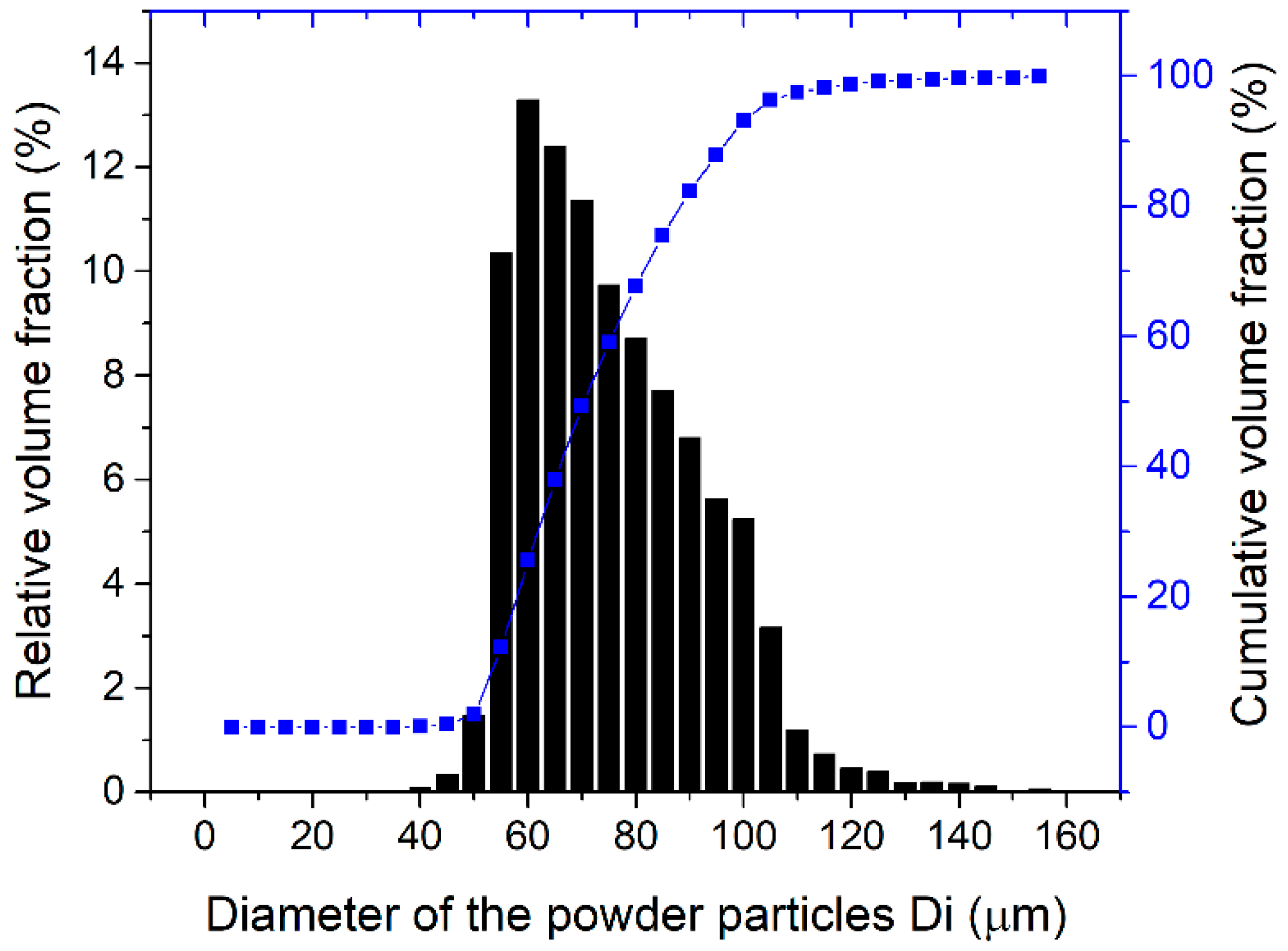
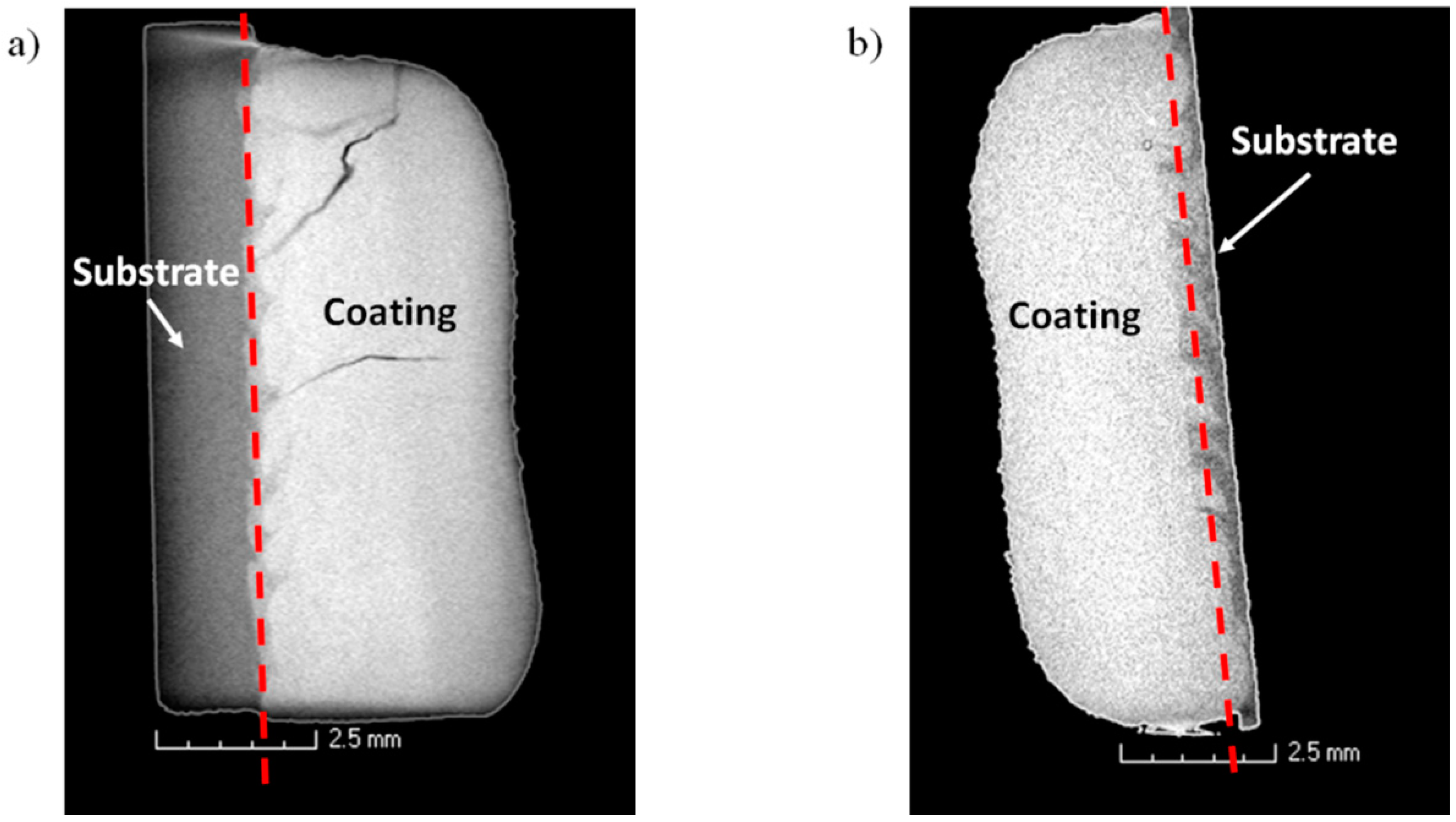

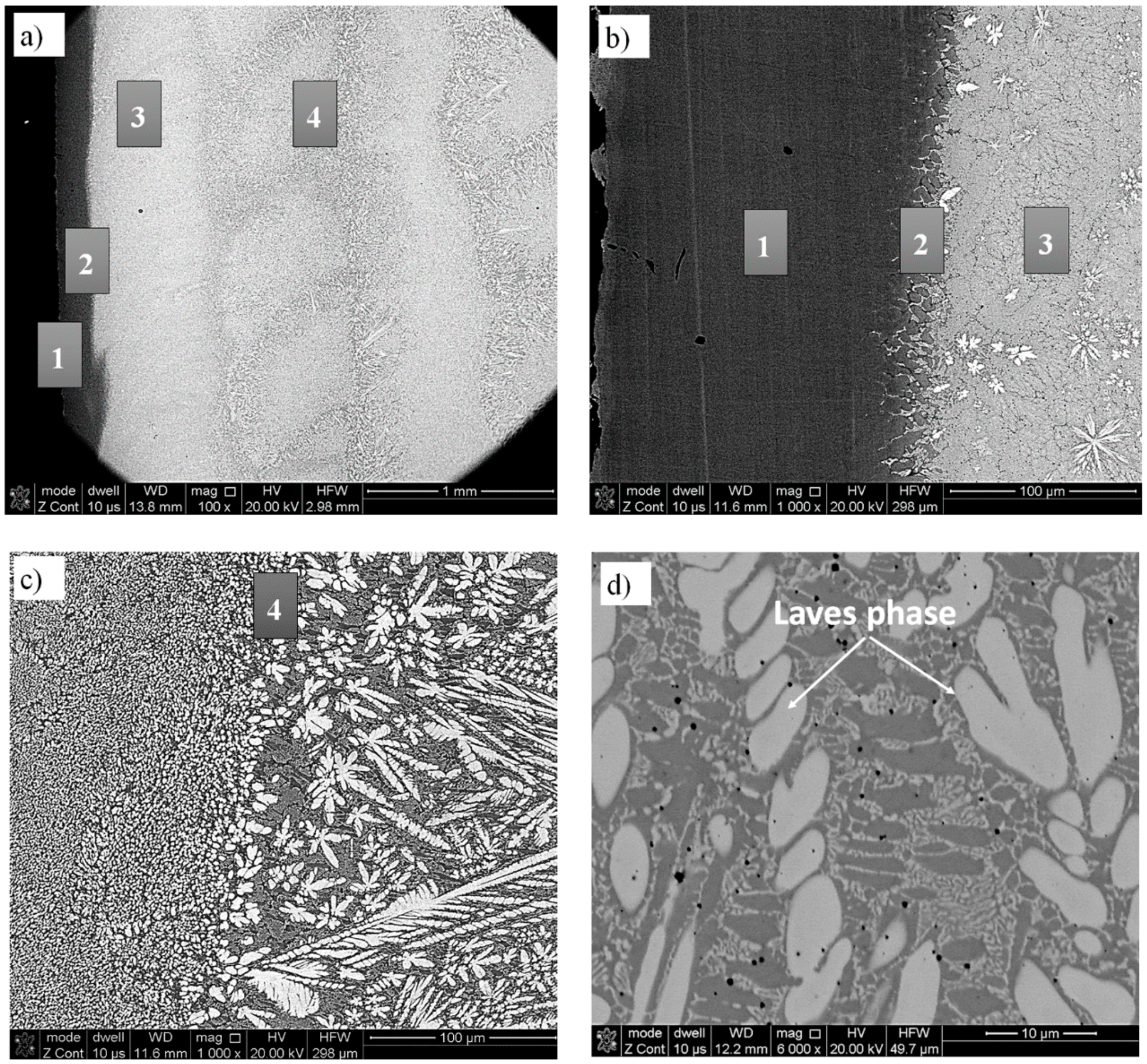
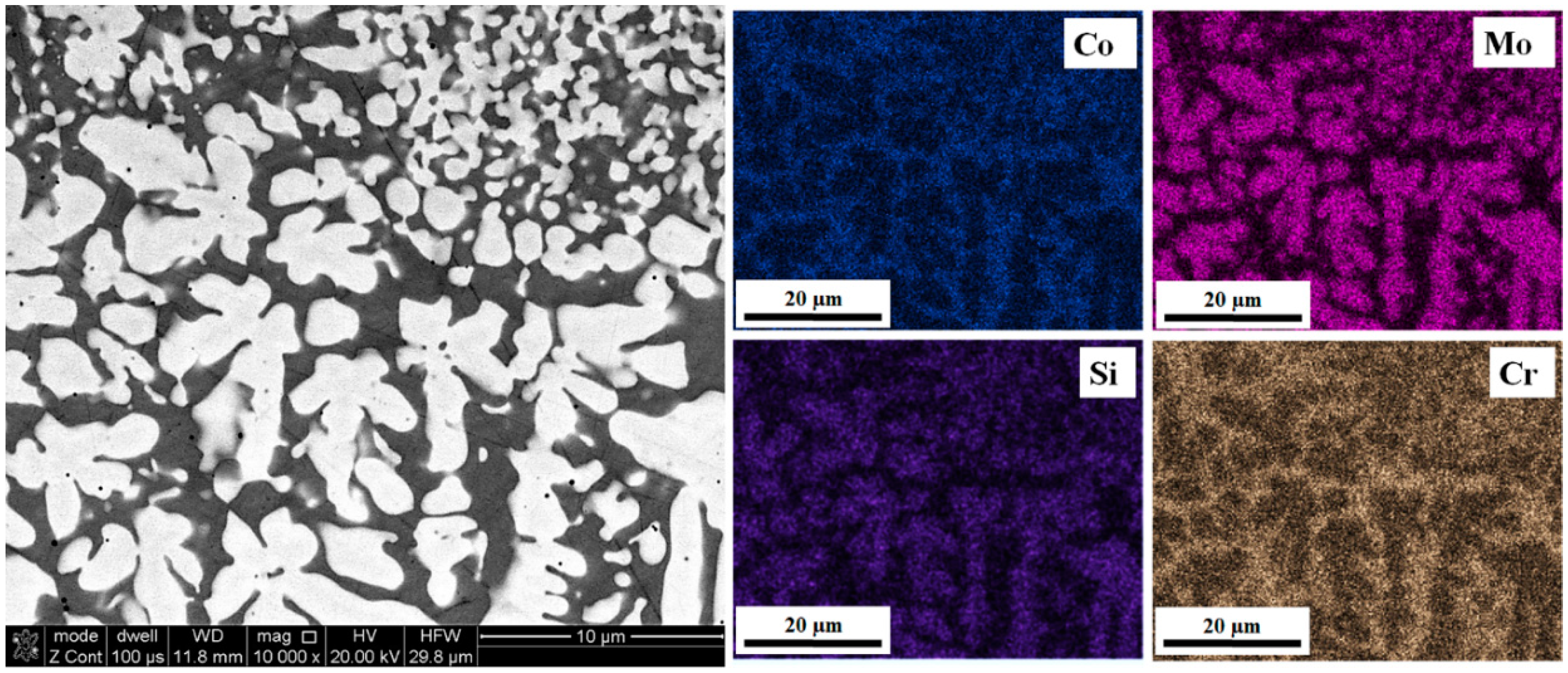
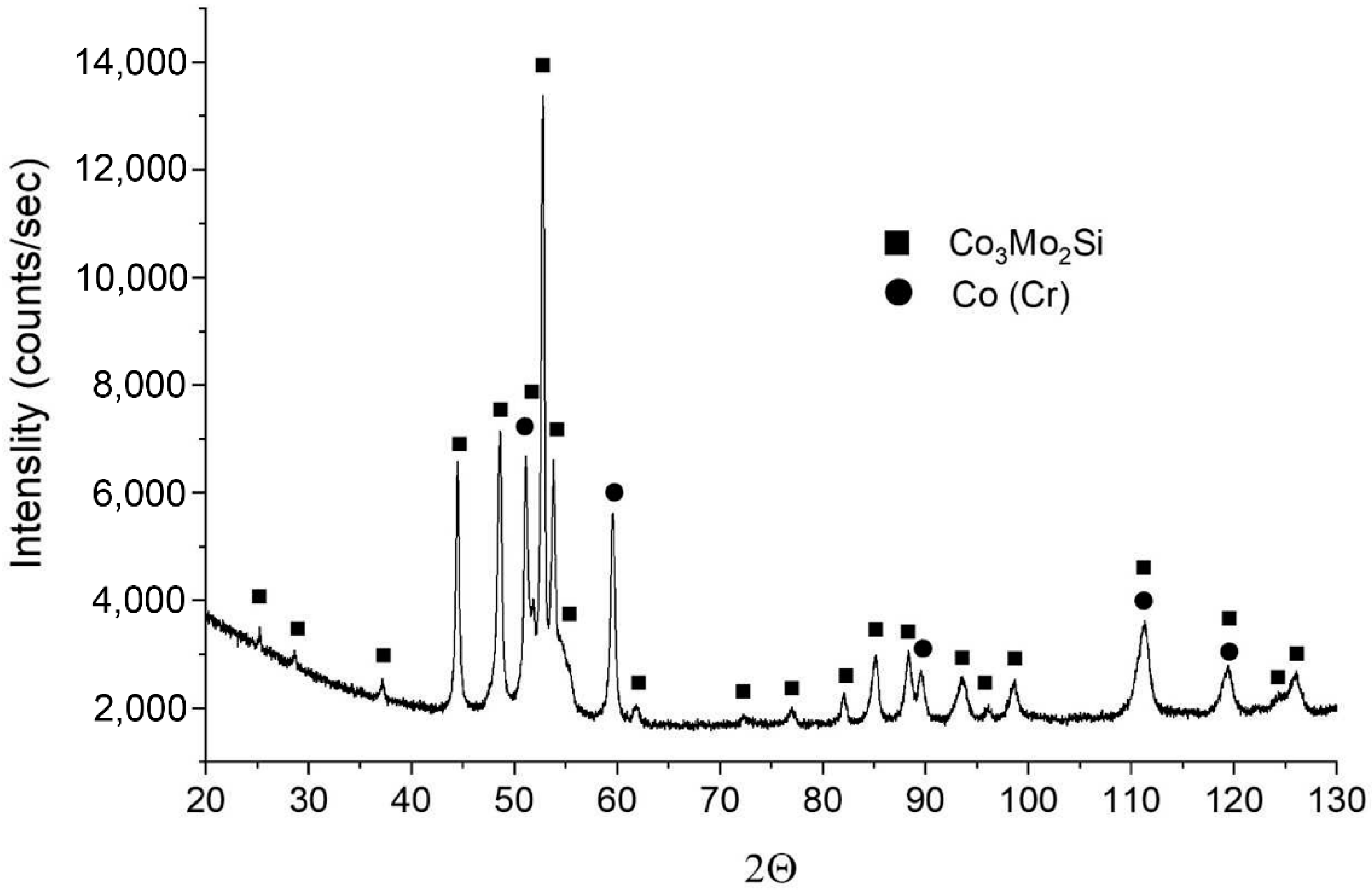
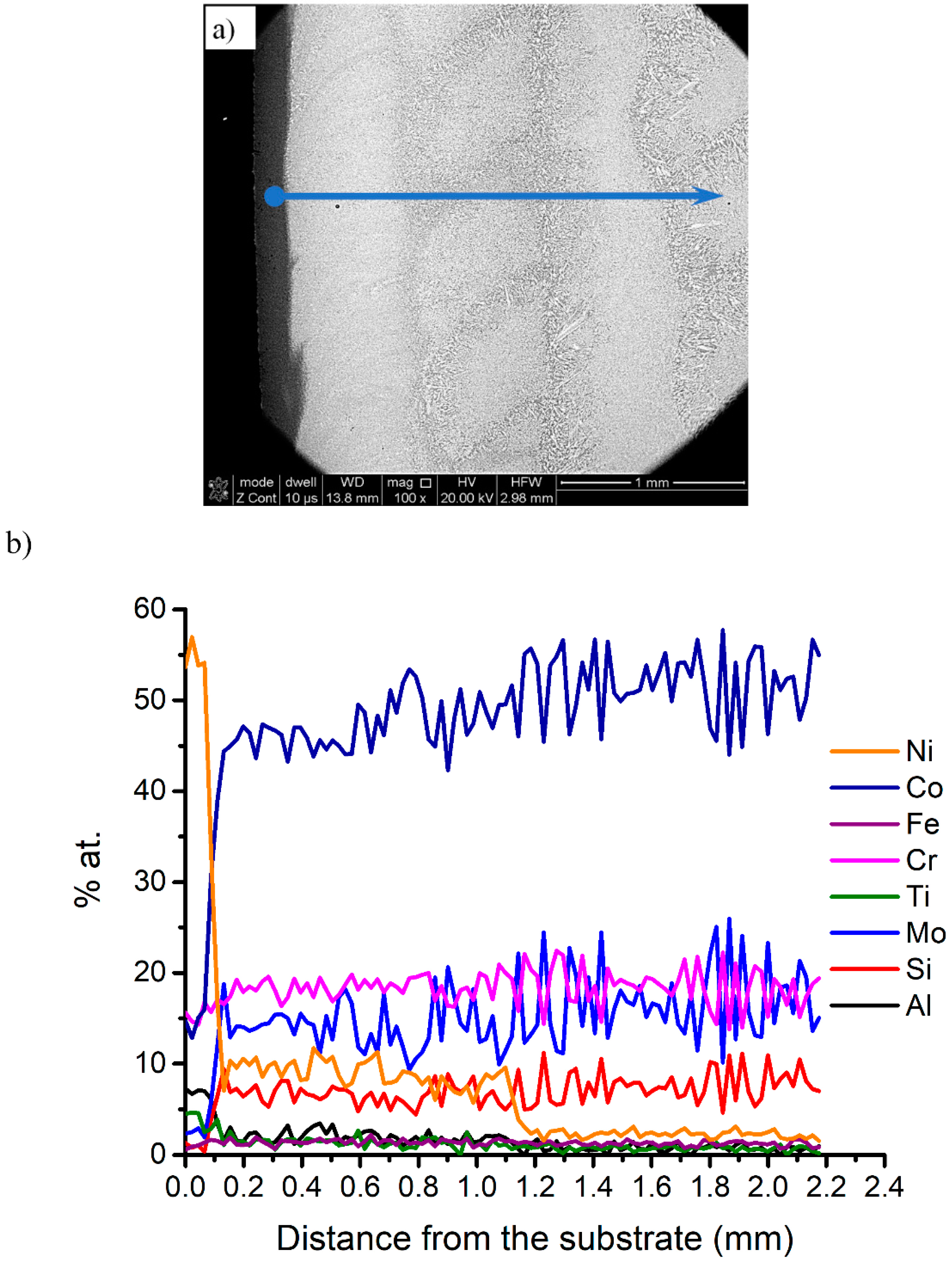

| T-800 Powder | ||||||
|---|---|---|---|---|---|---|
| Element Wt.% | Co | Mo | Cr | Si | Fe | Ni |
| Spherical particle | Bal. | 27 | 16.9 | 3.0 | 0.5 | 0.8 |
| Nominal (manufacturer) | Bal. | 27–30 | 16.5–18.5 | 3–3.8 | Fe + Ni max 3 | |
| RENE 77 Alloy | ||||||
|---|---|---|---|---|---|---|
| Element | Ni | Cr | Ti | Mo | Al | Co |
| wt.% | bal. | 15.2 | 3.3 | 3.8 | 3.7 | 16.4 |
| Sample Number | Energy Density * (J/mm2) | Powder Feeding Rate (g/min) | Substrate Temperature | Remarks |
|---|---|---|---|---|
| 1 | 25 | 7.6 | Ambient temperature | Numerous surface and volume cracks |
| 2 | 33.3 | 4.6 | ||
| 3 | 29.2 | 4.6 | ||
| 4 | 29.2 | 4.6 | Pre-heating working table to 100 °C | |
| 5 | 19.4 | 4.6 | Pre-heating working table to 200 °C | |
| 6 | 14.6 | 5.2 | Pre-heating working table to 200 °C | |
| 7 | 50.0 | 4.6 | Pre-heating working table to 200 °C | |
| 8 | 55.6 | 4.6 | Pre-heating working table to 200 °C | |
| 9 | 83.3 | 4.6 | Pre-heating working table to 300 °C | |
| 10 | 83.3 | 4.6 | Pre-heating working table to 300 °C with a laser of 150 W (energy density: 25 J/mm2) | No surface cracks. Coating dimensions diverge from the assumed geometrical model. |
| 11 | 83.3 | 4.6 | Pre-heating working table to 300 °C with a laser of 250 W (energy density: 41.7 J/mm2) | |
| 12 | 83.3 | 4.6 | Pre-heating working table to 300 °C with a laser of 300 W (energy density: 50 J/mm2) | |
| 13 | 83.3 | 4.6 | Pre-heating working table to 300 °C with a laser of 200 W (energy density: 33.3 J/mm2) | No cracks |
| 14 | 41.7 | 4.6 | Pre-heating working table to 300 °C with a laser of 200 W (energy density: 16.7 J/mm2) | Volume cracks |
| 15 | Two layers 50, the others 83.3 | 4.6 | Pre-heating working table to 300 °C with a laser of 200 W (final temperature—around 550 °C) | Volume cracks and porosity |
| 16 ** | Two layers 50, the others 83.3 | 4.6 | No cracks, porosity | |
| 17 | Two layers 50, the others 83.3 | 4.6 | Volume cracks | |
| 18 ** | Two layers 66.7, the others 83.3 | 4.6 | No cracks |
| Coatings T-800 | ||||
|---|---|---|---|---|
| Sample Number | Height (mm) | Width (mm) | Dilution Zone (mm) | Porosity (%) |
| 13 | 3.4 | 11.6 | 0.88 | 0.68 |
| 14 | 3.9 | 10.0 | 0.23 | 0.85 |
| 15 | 3.8 | 10.7 | 0.07 | 2.60 |
| 16 | 3.1 | 10.9 | 0.12 | 5.30 |
| 17 | 2.8 | 11.4 | 0.25 | 0.67 |
| 18 | 3.2 | 10.8 | 0.10 | 0.54 |
© 2019 by the authors. Licensee MDPI, Basel, Switzerland. This article is an open access article distributed under the terms and conditions of the Creative Commons Attribution (CC BY) license (http://creativecommons.org/licenses/by/4.0/).
Share and Cite
Durejko, T.; Łazińska, M.; Dworecka-Wójcik, J.; Lipiński, S.; Varin, R.A.; Czujko, T. The Tribaloy T-800 Coatings Deposited by Laser Engineered Net Shaping (LENSTM). Materials 2019, 12, 1366. https://doi.org/10.3390/ma12091366
Durejko T, Łazińska M, Dworecka-Wójcik J, Lipiński S, Varin RA, Czujko T. The Tribaloy T-800 Coatings Deposited by Laser Engineered Net Shaping (LENSTM). Materials. 2019; 12(9):1366. https://doi.org/10.3390/ma12091366
Chicago/Turabian StyleDurejko, Tomasz, Magdalena Łazińska, Julita Dworecka-Wójcik, Stanisław Lipiński, Robert A. Varin, and Tomasz Czujko. 2019. "The Tribaloy T-800 Coatings Deposited by Laser Engineered Net Shaping (LENSTM)" Materials 12, no. 9: 1366. https://doi.org/10.3390/ma12091366







